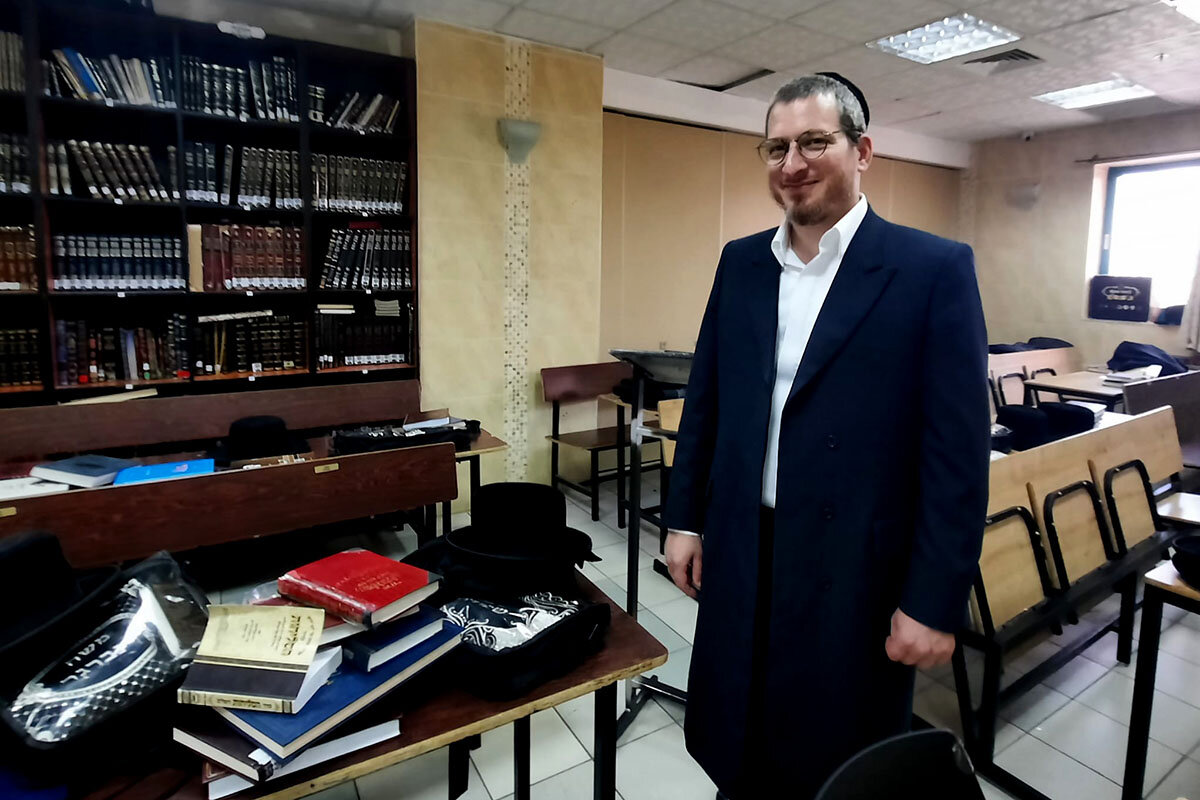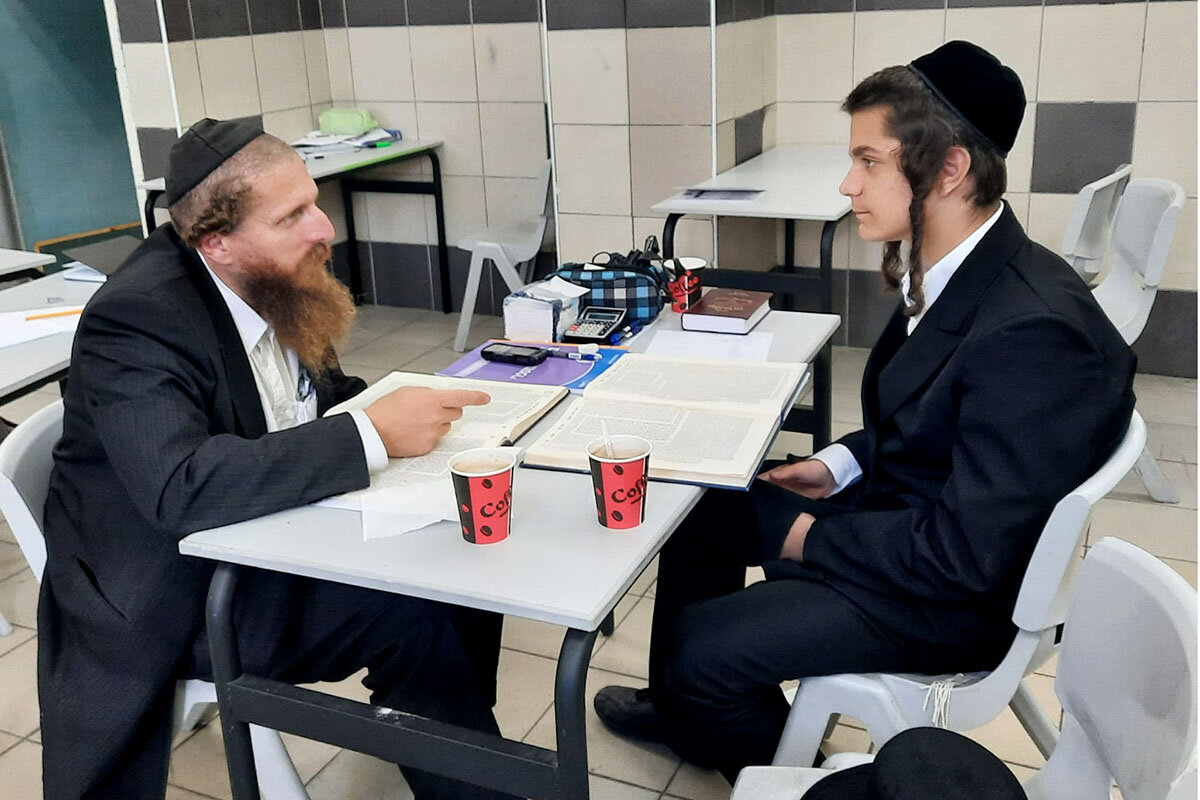In Israel, religious schools begin opening an old world to the new
Loading...
| Beitar Illit, West Bank
Although he grew up in modern Israel, Menachem Bombach says he hardly spoke a word of Hebrew, the national language, until the age of 20.
In his cloistered ultra-Orthodox neighborhood in Jerusalem, the spoken language was Yiddish, the lingua franca of Eastern European Jews since the Middle Ages.
Hebrew was reserved for prayer and the morning-to-night study of Jewish religious texts in the halls of his yeshiva seminary where he, like other ultra-Orthodox boys, was taught only enough math to count change at the store, and learned no English, science, or any other so-called secular subjects.
Why We Wrote This
Adapt to thrive? For Israel’s ultra-Orthodox, there’s a glimmer of change in a community notably impervious to it. Some boys are going to schools that teach “secular” subjects like math, science, and English.
Twenty years later, Rabbi Bombach is leading a tour around a four-story limestone-clad building, home to what’s known as a “yeshiva high school.”
The simply named Hassidic Seminary is the flagship of the Netzach network of schools he has created over the past seven years. Serving 1,400 students, the schools seek to bridge some of the divides between Israeli society at large and an impoverished yet fast-growing ultra-Orthodox population.
Most Haredim, Hebrew for the ultra-Orthodox who make up 12% of the population, live a world apart by design; they do not watch TV, are largely cut off from the internet, and are separated by neighborhoods, dress, schooling, and conservative beliefs in ways that have long put them in conflict with mainstream Israel.
While most of the country functions in the modern world – its economic growth fueled by high-tech – resentment grows that many Haredi men spend their lives studying with the help of government subsidies instead of holding jobs, and are largely exempted from military service that is compulsory for most. With 43% of the Haredi sector living in poverty, and their large and underemployed families fueling the community’s exponential growth – the status quo is seen as unsustainable.
National effort
Moshe Tur-Paz, a lawmaker from the centrist Yesh Atid party, is blunt about the stakes for Israel if the Haredim don’t join the workforce: mass emigration as the country sinks to the economic level of a developing nation. This is why, he says, there’s “a national effort to change course.”
At his school in Beitar Illit, an ultra-Orthodox settlement in the Judean Hills six miles south of Jerusalem, Rabbi Bombach stops into the beit midrash, the main study hall. Every day the hall is filled with pairs of students sitting side by side at wooden desks and poring over pages of the Talmud, which contains complex rabbinical discussions on Jewish law, ethics, and customs.
Upstairs he points out the classrooms where computer science and math are taught. In them lessons on artificial intelligence, coding, and differential equations are offered, alongside classes including English, physics, and “life skills” in which subjects including group dynamics and empathy are explored.
All of the students, he says smiling broadly, take Israel’s high school matriculation exams, a prerequisite for higher education.
“I want students to be God-fearing and Torah-loving, but also to be integrated into Israeli society,” he says.
And demand is growing for such an education, he says, citing long waiting lists. Another 7,000 study part time virtually. His schools are among 60 now in Israel that combine religious and secular studies for boys. (Because women are expected to work and support their husbands and children, girls are taught non-religious subjects in their schools.)
Resistance to change
Among Israel’s ultra-Orthodox, these schools reflect a glimmer of change in a community notably impervious to it.
It’s part a confluence of developments, including national policies markedly intensified under the new government to economically integrate the ultra-Orthodox. And that intersects with a trend among some 20% of the Haredim themselves to seek a more open, economically integrated way of life in which the men work while retaining the family’s strict adherence to Jewish law.
“This education will help me find work one day so I can make a good living,” says Tsvi Kahana, a 16-year-old student at Rabbi Bombach’s school, sidelocks dangling against his cheeks. “It also helps my religious and spiritual life.”
“Before we opened, people said it wouldn’t work. They called it nonsense,” says Rabbi Bombach, recalling his dismay, after months of preparation, that only five people showed for his inaugural presentation for parents eight years ago.
A wave of condemnation followed in pashkevilim – posters plastered on walls in ultra-Orthodox neighborhoods that declare what is and what isn’t considered acceptable behavior in the community – as well as protests. He was pelted with eggs; tar was poured once into the lock of his front door.
He persevered, propelled, he says, by the shock he felt as a young man when he realized he had no skill sets for modern life.
If Israel’s ultra-Orthodox community is the country’s fastest growing sector, it’s also among its poorest and youngest. Over half are children under 16.
“As a society we can’t survive that,” says Michael Nachtiler, Rabbi Bombach’s deputy. “We need schools like this to build an infrastructure for their future.”
Reviving a lost world
The current practice in which most ultra-Orthodox boys go to yeshiva and then, once they marry, continue to study full time is an outlier in Jewish history, where full-time study was accorded to only a tiny elite of Talmud scholars.
But among Israel’s Haredim it became the norm after a deal was struck in 1953 exempting the then-small number of yeshiva students from mandatory military service. Allowing them a life of study was a bid to rehabilitate the yeshiva world destroyed during the Holocaust.
“But now we are two and three generations later,” and the number studying full time is “far beyond what was ever imagined,” says Mr. Nachtiler, citing the 150,000 ultra-Orthodox boys and men in the religious seminary system. (In contrast, the estimated number of full-time scholars studying in prewar Europe was 5,000 – the enrollment in one of Jerusalem’s main yeshivas today.)
The goal, says Mr. Tur-Paz, the lawmaker, is that after seven years 30% of Haredi boys will study both religious and secular studies – up from the current 3%. He hopes that will lead to a tipping point in Haredi culture toward embracing this hybrid model.
Gilad Malach, an expert on Haredim at the Israel Democracy Institute, a Jerusalem think tank, says it is imperative the government invests generously in these schools as part of its policy of carrots and sticks to get more Haredim working.
Hunger for general knowledge
In the internal Haredi divide between those who are for and against isolation, Shmuel Kaminski and his wife, Esty, fall on the side of integration. They send two of their sons to the yeshiva high school in Beitar Illit, despite pushback from relatives and the social stigma that came with the decision.
“It’s important first of all to safeguard the Haredi tradition, but being able to study towards going to college opens the doors to the world,” says Mr. Kaminski.
“Growing up I never dreamed something like this could exist,” he says. He excelled in the yeshiva world, even qualifying to litigate in religious courts. But he was hungry for more general knowledge and felt stung by a life of poverty. Ten years ago, the father of six took a government-sponsored technology course for Haredi men.
He was among the few to complete it. Years in the study house debating religious texts and commentaries did not equip him or the others with what they needed to learn computer coding.
Mr. Kaminski found work as a programmer, but he recounts a frustrating journey.
“And I still don’t have a university degree,” he says. “Why should my sons tread this same difficult path?”
He would welcome his sons becoming religious scholars. But echoing what other Haredi parents like him say, he wants them to be educated to have options and then decide.
“It’s a long process,” he says of convincing more Haredim to accept such schools. “But I feel like we are seeing a wave, a wave that is slowly growing.”








